Some argue that the Plastic Packaging Tax doesn’t go far enough. The concern being that some will decide it’s easier, or even cheaper, to simply pay the tax rather than adopt the sustainable practises required to avoid it. Although in some circumstances this could be true, it seems unlikely given the adverse spotlight of publicity that might well ensue.
But, with a surprising 77% of British business still unaware what the Plastic Packaging Tax is, or that it even exists, should more be done to spread the word? As, if businesses are unaware of the situation, it is impossible for them to do anything about the situation.
What is the Plastic Packaging Tax (PPT)?
As mentioned, the PPT is a piece of new environmental legislation that came into force on April 1, 2022. It applies to plastic packaging produced in, or imported into, the UK that contains less than 30% recycled plastic content. It is charged at £200 per metric tonne, and is payable by businesses that manufacture or import 10 tonnes of plastic packaging, or more, per year.
The tax covers two types of plastic packaging: those designed for use in the supply chain, and those destined for consumer single-use. If your packaging is made up of several components – such as bottles, caps and labels – each component must be accounted for within the PPT.
There are four categories of packaging that are exempt from the tax. These are products that are:
- used for the immediate packaging of licensed human medicine
- permanently recorded as set aside for non-packaging use
- used as transport packaging to import multiple goods safely into the UK
- used in aircraft, shipping and rail goods stores
So, unless in one of the categories stated above, businesses need to register and pay the PPT as from April.
Why do we need the Plastic Packaging Tax?
The plastic problem is a double-edged sword. The manufacturing of plastic requires the use of petrochemicals and oil, which as we know is detrimental to the environment, whilst plastic pollution of our oceans and general surroundings causes issues for wildlife and aquatic toxicity.
To drive this home, the manufacturing process of virgin plastic generates five times more CO2 emissions in its production and transport than recycled plastic.
A recent study from ZSL (Zoological Society London) and Bangor University pushes the argument further and claims that the ‘plastic and climate change crises exacerbate one another and urge that they must be tackled in unison to save precious marine life’. Much of this relates to the fact that as extreme weather worsens, the distribution of micro-plastics and other pollutants to remote and pristine areas will increase.
The study goes on to look at three keyways in which plastic pollution and the climate crisis are connected. First is the general impact of plastic and plastic production contributing to greenhouse gases. Second, as mentioned, is how extreme weather – such as hurricanes and flooding – increase the distribution of plastic pollution. With the third point looking at how particular marine species and ecosystems vulnerable to both.
The impact that plastic pollution is having on marine biodiversity is overwhelming. Many species mistakenly ingest plastic pollution, and a number of entire habitats have been polluted with microplastics. Worryingly, sea ice has been cited as a major trap for microplastics. As this ice melts due to global warming, these microplastics will be dispersed into the oceans – often into some of the last few remaining ‘safer’ parts of the ocean.
We could continue on what the plastic issue is, and the detrimental impact it has on climate change, aquatic life and marine biodiversity – not to mention its impact to wildlife on the land to – but there is just too much to cover. The bottom line is, the negative impact that virgin plastic has on our planet far outweighs its convenience as a packaging material.
How is it looking?
A recent survey, conducted by YouGov, shows that only 22% of manufacturing and retail business asked were already opting for recycled plastic in their packaging – a disappointingly low number if the UK is to reach its 2050 net zero target. The study also showed that, of those businesses who had made changes to their plastic packaging –
- 66% have reduced the amount of unnecessary plastic packaging
- 58% now us recycled content
- 54% have changed the packaging design to make it more recyclable
- 39% have decided to use alternative material to plastic for their packaging
At BioHygiene, the PPT won’t apply, nor will it require us to make any changes to our current packaging. As a forward-thinking, sustainably minded manufacturer, we have used 100% post-consumer recycled plastic (PCR) in all of our packaging for a number of years already.
The benefits of using PCR are numerous. It allows us to reduce CO2e by 85%, means there is 0% virgin plastic in our packaging and allows us to develop closed loop recycling systems with our customers.
Another aspect of our products that severely reduces the amount of packaging used is our super-concentrate technology. Our biotechnology allows us to concentrate products to as high a level as 1:200. If less product is used, each bottle will last longer, reducing the need for customers to order extra bottles – this also saves on storage and transport emissions and cost.
Additionally, our labels, caps and triggers can all be recycled: our cardboard is made from 100% recycled material and is carbon neutral, and even our plastic shrink wrap is biobased as well as 100% recyclable and carbon neutral.
Is Plastic Packaging Tax Enough?
Considering the urgency of the situation, and the amount of work that needs to be done, it could be argued that the inclusion of just 30% recycled plastic is a little unambitious. As BioHygiene, and many other companies outside our sector, have shown – it’s quite possible to do more than the minimum required.
An additional scheme that looks set to be implemented in 2023/24 is the Extended Producer Responsibility (EPR). The British Plastics Federation (BPF) say this aims to cover the costs of end-of-life treatment and to incentivise producers through the fees they pay to ensure the products on the market are recyclable – and any unnecessary packaging material reduced. It is hoped that this will help meet waste reduction and recycling targets and increase reuse of plastics.
Another aim of the scheme is to shift the cost of collecting, sorting and cleaning material intended for recycling away from local authorities to industry. Again, this could provide more labour and more financing to the sector.
The PPT and expected EPR schemes, and other legislative suggestions are without a doubt a step in the right direction. However, to drastically reduce plastic pollution – which is what is necessary – we need responsible businesses, and entire industries, to go above and beyond the baseline level of legislation. Which we are proud to say, we do.




